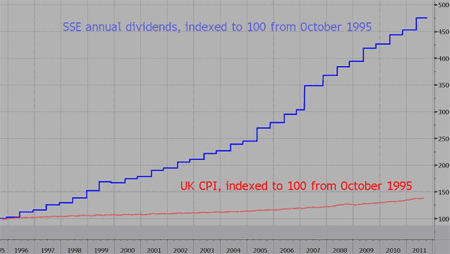We’ve been bullish on Britain’s energy suppliers for a long time. And it’s paid off.
For example, since we tipped Scottish & Southern Energy (LSE: SSE) just over a year ago, the shares have notched up a total return (ie including reinvested dividends), of almost 24%. That compares with a sub-5% overall performance from the FTSE 100 over the same period.
Holding these shares has been a great way to hedge against soaring electricity and gas bills, which have risen by 15% since June alone, according to energy regulator Ofgem.
But with popular anger rising, and threats of increased competition to drive down the price of energy, is it time to sell out of energy utilities?
We don’t think so. Here’s why…
Could more competition be bad news for energy suppliers?
The profits being made from customers by Britain’s ‘Big Six’ energy firms are now over eight times higher than in June, Ofgem said last week. This summer’s gas and electricity price hikes mean suppliers are making £125 of annual profit from a typical customer, up from £15 mid-year.
There’s more pain ahead. The cost of wholesale gas and electricity, which utilities must buy before they can supply the general public, has been climbing. That could lead to even higher future bills.
However, last week SSE took the rest of the British energy industry by surprise. The company plans to start auctioning part of its power supplies on the open market.
What does this mean? In theory, it would open up the UK’s energy market to greater competition. This could mean lower prices being offered to consumers. SSE would suddenly become the consumer’s new best friend after many years of being one of the hated ‘Big Six’. Further, the shift could also suggest lower profits for suppliers.
So should you sell out of the sector now?
Why British energy prices just won’t fall
In short, no. I’ll explain why not.
For a start, SSE’s initiative doesn’t make much difference to what was already on the cards. Ofgem has already proposed forcing energy firms to auction off a fifth of their energy production by 2013.
Indeed, this move by SEE is just “smoke and mirrors”, reckons Darren Braham of Britain’s biggest independent electricity supplier, First Utility. It will “have a negligible impact on newer entrants growing in the market, competition and consumers”, he says.
In other words, the move is about SSE making itself look squeaky clean at a time when Ofgem is mulling over setting up a Competition Commission to probe industry pricing.
This is all about politics, as Tom Bawden notes in The Independent. Energy providers “have to be seen to be doing something to satisfy politicians and customers”.
However, he adds, the ‘Big Six’ don’t have scope to lower prices much”. Sure, “auctions could… force existing operators to become a bit more customer friendly”. But with “increasing environmental requirements and a much-needed infrastructure overhaul looming, prices are only going to go up”.
The trouble is, Britain has to start seriously investing in its energy supply to avoid the risk of rolling power cuts in a few years’ time. That means that the government must persuade our big energy firms to start big capital spending programmes. So despite all the talk, it’s unlikely to get too tough with them over pricing now.
Indeed, an energy auction could send prices up fast. Germany trades ten times as much electricity as Britain. And as Lucy Tobin points out in the Evening Standard, “just one chilly forecast from a German Michael Fish makes the market nervous and sends prices soaring”.
SSE has been a great investment
Let’s get back to SSE. Sure, you may not like the company. And with prices likely to keep rising, it’s not going to get any more popular with the general public. It’s your call about whether you’re comfortable with buying the stock.
But as an investment, it’s been a long-term winner. And not just because the shares have done well. It’s also provided shareholders with a high and fast-rising income – as this chart shows.

Source: Bloomberg
The red line is UK consumer price inflation (CPI) over the last 16 years. Over that time the cost of living has risen around 40%.
But look at the blue line. This shows the growth in dividends paid by SSE from the same start point. Over 16 years, the firm’s payout has surged by 375%. Even better, it’s been a steady upward progression.
Had you bought SSE shares in 1996, the current dividend yield on the purchase cost of your investment would be over 20%. It’s amazing how ‘boring’ utility companies can make you so much more money than you might expect.
OK, the next 16 years may not be quite so fruitful for shareholders in SSE. But I’d be happy to stick with the stock. On a current year p/e of below 12, and prospective yield of almost 6%, it’s still good value. And if stock markets drop again soon, or if there’s a wobble over the latest news, you could get the chance to snap it up even cheaper.
Category: Economics

